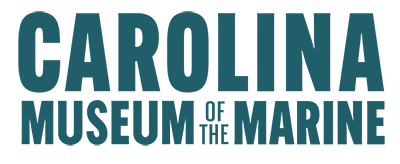Vol 1, No. 7 July 2022 FRONT AND CENTER – Read our article in Leatherneck Magazine!
FRONT AND CENTER
Vol. 1, No 7, July 2022
Mission
Honoring the legacy of Carolina Marines and Sailors and inspiring future generations.
In Memoriam
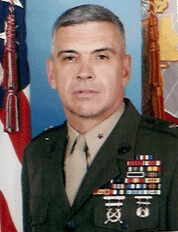
Brigadier General Richard F. Vercauteren, USMC (Ret)
9 February 1945 – 16 June 2022
The Board of Directors of Carolina Museum of the Marine announces with sadness the passing of our friend and colleague Brigadier General Richard F. Vercauteren, USMC, Ret., on Thursday, 16 June 2022.
BGen Vercauteren was born 9 February 1945 in Manchester, New Hampshire. He graduated from Providence College in Rhode Island in June of 1967 and was commissioned a second lieutenant in November of that year. After graduating from The Basic School at Quantico, Virginia, 2ndLt Vercauteren was assigned to 2d Battalion, 9th Marines in Vietnam where he served with distinction as a platoon commander.
Among his many assignments, BGen Vercauteren was a United Nations Military Observer and operations officer in Egypt, Israel, Syria, and Lebanon, Aide-de-Camp to the Commanding General Fleet Marine Force Atlantic, Commanding Officer of 3d Battalion, 2d Marines, Commanding Officer of Company F, Marine Security Guard Battalion in Nairobi, Kenya commanding Marine guards at 33 embassies in Sub-Saharan Africa, and Commanding General, 1st Marine Expeditionary Brigade, Marine Corps Air Station Kaneohe Bay, Hawaii.
BGen Vercauteren is a recipient of the Distinguished Service Medal, Silver Star Medal, Legion of Merit, Meritorious Service Medal with two gold stars, Navy Commendation Medal with Combat “V,” and the Combat Action Ribbon. He also received the Navy League’s General Holland M. Smith Award for operational proficiency.
In addition to a B.A. degree from Providence College, BGen Vercauteren held an M.A. in International Affairs from Georgetown University and an M.A. in Business Administration from Central Michigan University. He was a Commandant of the Marine Corps Fellow in Foreign Politics at the Massachusetts Institute of Technology and Fellow in National Security Affairs at Harvard University.
BGen Vercauteren is survived by his wife, Gail, of 50 years.
In June 2020, BGen Vercauteren was elected Chair of the Board of Directors, Carolina Museum of the Marine where he performed his duties with customary energy, collegiality, and sound judgment. As Chair, BGen Vercauteren led the successful multi-year effort working with local members of the North Carolina General Assembly to secure a State Capital Infrastructure Fund grant in the amount of $26 million to construct the Museum. He also initiated a significant restructuring of the organization, began a nation-wide search for a CEO and launched the successful first pilot programs of the Al Gray Marine Leadership Forum. For decades to come, all who walk through the doors of the Museum or participate in the Al Gray Marine Leadership Forum will benefit from BGen Vercauteren’s determination to make the Carolina Museum of the Marine.
Requiescat in Pace
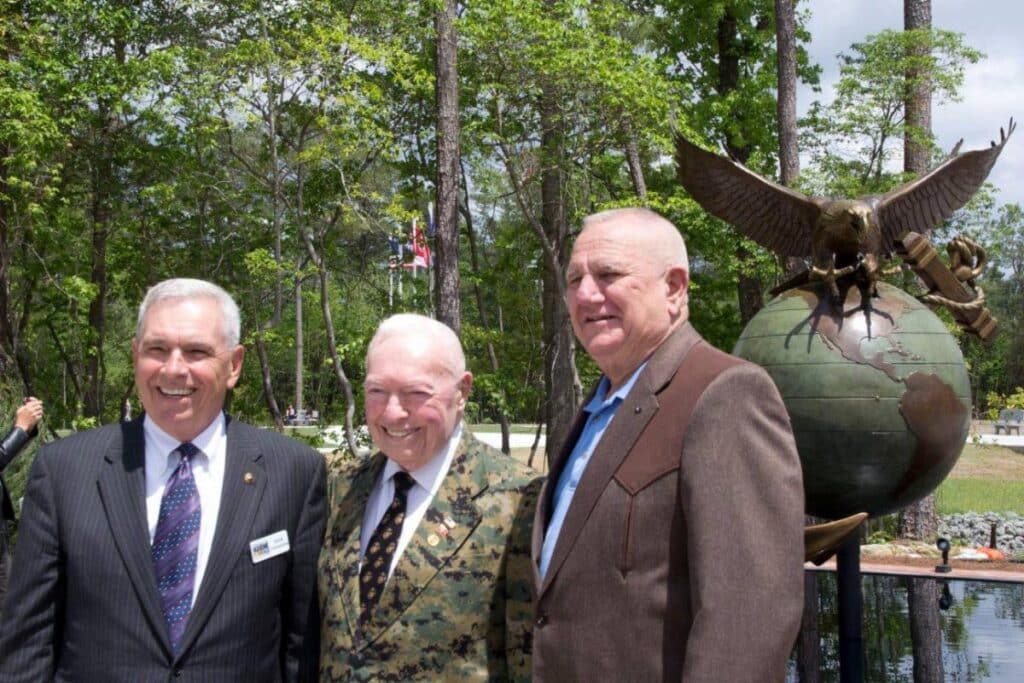
Thank you to Leatherneck Magazine for featuring us this month!
Cramer Serving as Acting Chair of the Board

Acting Board Chair/Vice Chair
Under our organization’s Bylaws, Vice Chair Mark Cramer, has been serving as Acting Chair of the Board since former Chair Dick Vercauteren’s hospitalization in late April. Cramer has been a member of the Board since 2019 and Vice Chair since 2020. He also serves as Chair of the CEO Search Committee and has been instrumental in the start-up the activities of Al Gray Marine Leadership Forum.
Cramer is an attorney and for over 42 years has had a career encompassing legal representation and executive leadership of private, nonprofit and governmental organizations at the local, state and federal levels. He was a co-founder and later served for seven years as President of the Institute for Defense and Business and the Center of Excellence in Logistics and Technology (LOGTECH) in Chapel Hill, North Carolina, during which time he also was an adjunct faculty member of the Kenan-Flagler Business School at the University of North Carolina at Chapel Hill.
Cramer is currently a Senior Advisor for FTI Consulting’s Supply Chain Global Solutions Practice. He is a member of the Board of Advisors of the U.S. Chamber of Commerce Foundation and a former member of the Administrative Conference of the United States, the N.C. General Statutes Commission and the Electoral College. Admitted to the U.S. Supreme Court Bar, he is also a member of the Bar in North Carolina, the District of Columbia and Florida.
Union and Liberty in Early America, II
James Danielson, PhD
In the last issue of “Front and Center,” we examined the nature of the American state and began to consider how early Americans worked out a way for the states to effect their security within a union that protected their liberty. In this issue, we will describe the American political order that prevailed among us from 1776 to 1861.
In 1963, Richard M. Weaver published an essay in the journal Modern Age titled “Two Types of American Individualism.”[i] Weaver was an important American political theorist best known for the book Ideas Have Consequences. In the essay we are considering, Weaver uses two iconic American figures as examples of individualism: John Randolph of Roanoke Plantation, Virginia, and Henry David Thoreau of Concord, Massachusetts. Weaver’s discussions of Thoreau and Randolph neatly outline the consequences for liberty of the views of the individual held by the Puritans who settled New England and the Anglican Cavaliers who migrated to the Tidewater region of Virginia. However, Thoreau represents the understanding of liberty and of union that came to prevail after 1865, and Randolph embodies the ideas of liberty and union in America before the war of 1861-65. For this reason, we will focus on Randolph. Weaver begins his essay writing:
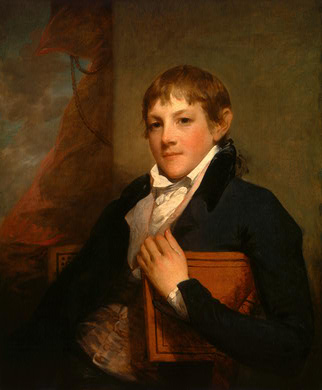
“Ours is an age in which individualism is publicly praised and privately snubbed: individual liberty is called the chief goal of all our striving, while at the same time we hear off-stage whispers to the effect that the social cost of individualism is too great a charge to be borne by a democratic world.”
Individualism is resident deep in our history as a part of our heritage that we are urged to hold dear, Weaver says, yet the modern world presents us with tensions that drive many people to seek refuge in more collectivist political arrangements.
John Randolph was born June 2, 1773 on an estate named Cawsons (now in Hopewell, Virginia) near Petersburg. He was a member of the Virginia gentry but had an eclectic education attending at various times Princeton, Columbia, and William and Mary, after which he read law for three years under his uncle, Edmund Randolph, who was President Washington’s attorney general. Randolph began his political career as an unstinting defender of the sovereign rights of states in opposition to the aging Patrick Henry who, as he grew old, became an exponent of a strong central government. Over the course of his life, however, Randolph never wavered. Randolph’s biographer wrote of him: “He was the most consistent of all the politicians that ever lived in the republic.” What Randolph was consistent about was opposing what he saw as the tendency of Congress to move away from the republican principles in the Constitution, and importantly the principle of federalism, for these Randolph saw as the “anchor of liberty.” For example, Randolph was ardently opposed to establishing a national bank because there is no authority to do so delegated to Congress in the Constitution.[ii] This is by design. Delegates to the Philadelphia Convention in 1787 considered empowering the new federal government to charter corporations, including banks, but rejected the idea on grounds that the surest way to keep government within the strict limits assigned to it in the Constitution is to keep its purse light. A federal Congress with its own bank, or banks at its discretion, would thwart this important goal. Nevertheless, on February 25, 1791, during President Washington’s first term, Congress passed a law creating the First Bank of the United States.
In 1828, Randolph supported the election of Andrew Jackson as president. Randolph saw Jackson as a defender of state sovereignty and local self-government, but Jackson proved to be in favor of protectionist tariffs that did significant financial harm to southern planters. South Carolina had written into its ratification statement when it adopted the Constitution that it reserved the right to nullify within its borders any federal law it saw as opposed to the interests of South Carolinians. South Carolina nullified the tariffs; Jackson threatened to invade. Alarmed, Randolph appealed to an old political enemy, Henry Clay of Kentucky.
Clay was an important American politician who served in the House of Representatives as Speaker, in the Senate, and as Secretary of State. He was an ambitious man, but a skilled political negotiator who came to be called the “Great Compromiser” because of his ability to find acceptable middle paths between parties to political controversy. Clay was able to negotiate a compromise bill that eliminated (for a time) the principle of protectionism and reduced the tariff. South Carolina agreed to pay the reduced rates, and the standoff abated. Read more…
CAROLINA MARINES
Marine Corps Base Camp Lejeune
Marine Corps Air Station Cherry Point
Marine Corps Air Station New River
Marine Corps Camp Geiger | Marine Corps Camp Johnson
Marine Corps Recruit Depot Parris Island
Marine Corps Air Station Beaufort
his issue of FRONT AND CENTER features
Marine Corps Air Station Beaufort.
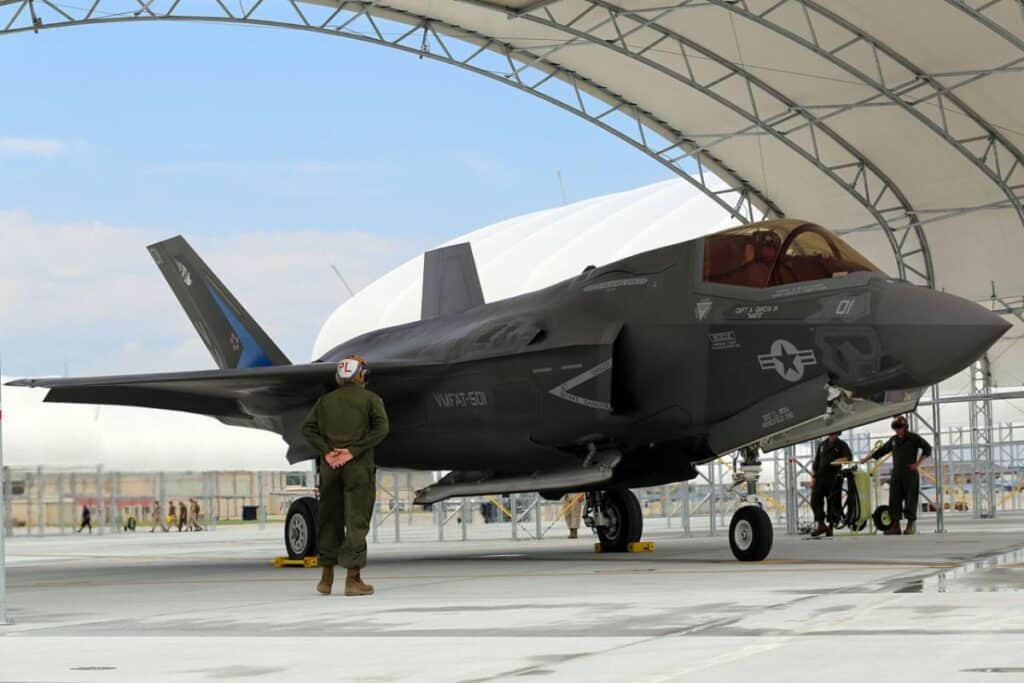
By Cpl. John Wilkes – https://www.dvidshub.net/image/1451665, Public Domain,
https://commons.wikimedia.org/w/index.php?curid=40877040
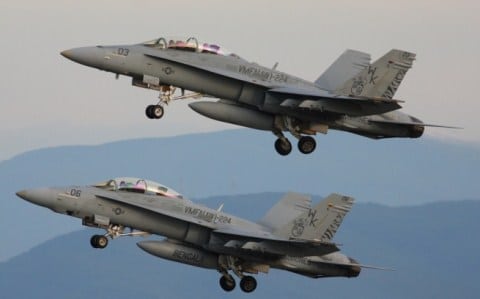
Marine Corps Air Station Beautfort. Photo: MilitaryBases.Com
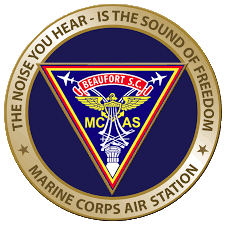
Naval Air Station Beaufort was commissioned on June 15, 1943, for advanced training operations of anti-submarine patrols during World War II. It was deactivated in 1946 and reactivated in 1956.
On March 1, 1960, it was re-designated Marine Corps Air Station Beaufort.
On September 19, 1975, the airfield was named Merritt Field in honor of Major General Lewie G. Merritt, USMC, a 1917 graduate of The Citadel, The Military College of South Carolina. A native of Ridge Spring, Merritt was a Marine Aviation pioneer who served in both World Wars and commanded several major flying units in the South Pacific during World War II, after retirement he also served as legal counsel to the South Carolina Legislature.[3]
The air station encompasses 6,900 acres (28 km²). It is also associated with a large air-to-air combat area off the coast of South Carolina and Georgia as well as a 5,200 acre (21 km²) air-to-ground combat and bombing range in McIntosh County, Georgia. Also attached to the base is the housing complex of Laurel Bay, just 3 miles (5 km) from the station, that provides family housing for area servicemembers.
Formerly home to USMC F-8 Crusader and F-4 Phantom II operations, MCAS Beaufort currently hosts all active duty USMC F/A-18 air operations on the East Coast, said aircraft and squadrons being assigned to Marine Aircraft Group 31 (MAG-31). The mission of MCAS Beaufort is to provide support as an operational base for MAG-31 and its associated squadrons, Marine Corps support units and tenant Navy strike fighter squadrons. The mission of the Marine Aircraft Group (MAG-31) is to conduct anti-air-warfare and offensive air support operations in support of Fleet Marine Forces from advanced bases, expeditionary airfields, or aircraft carriers and conduct such other air operations as may be directed. Two US Navy F/A-18 strike fighter squadrons under the claimancy of Strike Fighter Wing Atlantic at NAS Oceana, Virginia were also previously homeported at MCAS Beaufort. The population of the on-base “city” includes nearly 4,000 active-duty servicemembers and more than 700 civilian workers. As is the case with many air bases, MCAS Beaufort hosts a bi-annual air show open to the public.
https://en.wikipedia.org/wiki/Marine_Corps_Air_Station_Beaufort
U.S. Marine Corps photo illustration by Staff Sgt. Brittney Vella
Please join us in supporting the mission of
Carolina Museum of the Marine
When you give to our annual campaign, you help to ensure that operations continue during construction and when the doors open!
Stand with us
as we stand up the Museum!
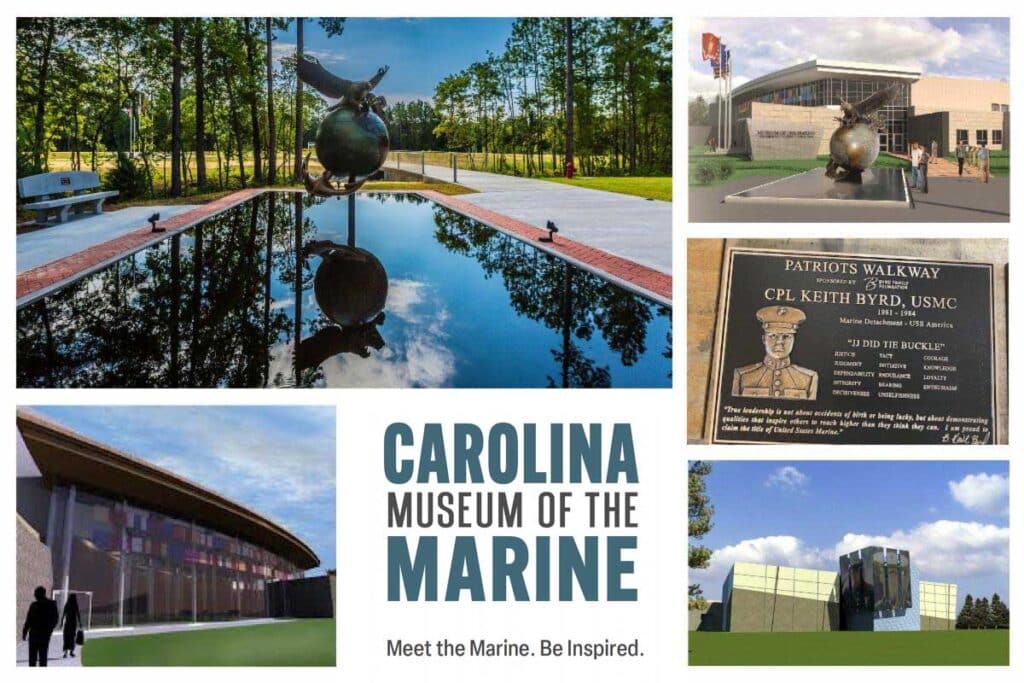
Copyright July 2022
Carolina Museum of the Marine
2021-2022 Board of Directors
Executive Committee
Mr. Mark Cramer, JD – Acting Chair and Vice Chair
CAPT Pat Alford, USN (Ret) – Treasurer
Col Joe Atkins, USAF (Ret) – Secretary
Col John B. Sollis, USMC (Ret) – Immediate Past Chair
General Al Gray, USMC (Ret), 29th Commandant – At-Large Member
LtGen Gary S. McKissock, USMC (Ret) – At-Large Member
Members
Mr. Terry Branton
Mr. Tom DeSanctis
MGySgt Osceola Elliss, USMC (Ret)
Col Chuck Geiger, USMC (Ret)
Col Bruce Gombar, USMC (Ret)
LtCol Lynn “Kim” Kimball, USMC (Ret)
CWO4 Richard McIntosh, USMC (Ret)
CWO5 Lisa Potts, USMC (Ret)
Col Grant Sparks, USMC (Ret)
GySgt Forest Spencer, USMC (Ret
Staff
BGen Kevin Stewart, USMC (Ret), Chief Executive Officer
Ashley Danielson, Executive Director | VP of Development
SgtMaj Joe Houle, USMC (Ret), Operations and Artifacts Director
Richard Koeckert, Accounting Manager
Carolina Museum of the Marine is a nonprofit organization that is rigorously nonpartisan, independent and objective.


